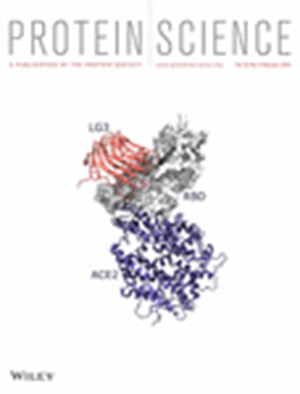分析表皮生长因子受体结合热点,设计新型表皮生长因子受体抑制生物制剂
IF 4.5
3区 生物学
Q1 BIOCHEMISTRY & MOLECULAR BIOLOGY
引用次数: 0
摘要
表皮生长因子(EGF)受体(EGFR)是由七种 EGF 样配体之一与其外结构域结合而激活的。配体结合会导致表皮生长因子受体二聚化并稳定活性受体构象,从而激活下游信号传导。表皮生长因子受体的异常激活通过表皮生长因子受体的过度表达/扩增、对其正负调控因子的调节和/或表皮生长因子受体内的激活突变而导致癌症进展。表皮生长因子受体靶向治疗抗体通过结合表皮生长因子受体的外显子域来阻止二聚化和与内源性配体的相互作用。然而,这些抗体在临床上取得的成功有限,部分原因是表皮生长因子受体外显子抗性突变,而且只适用于表皮生长因子受体驱动的癌症患者。这些局限性表明,需要探索其他表皮生长因子受体靶向生物制剂来治疗表皮生长因子受体驱动的癌症。为此,我们利用 Rosetta 大分子建模软件,分析了已知抑制性生物制剂的表皮生长因子受体界面,并确定了内源性配体的结构,从而突出了每个残基上最重要的相互作用。我们利用这一分析来确定表皮生长因子受体靶向生物制剂的结构决定因素。我们认为,常见的结合基团是合理设计新的表皮生长因子受体靶向生物制剂(如多肽、抗体和纳米抗体)的基础。本文章由计算机程序翻译,如有差异,请以英文原文为准。
Analysis of EGFR binding hotspots for design of new EGFR inhibitory biologics
The epidermal growth factor (EGF) receptor (EGFR) is activated by the binding of one of seven EGF‐like ligands to its ectodomain. Ligand binding results in EGFR dimerization and stabilization of the active receptor conformation subsequently leading to activation of downstream signaling. Aberrant activation of EGFR contributes to cancer progression through EGFR overexpression/amplification, modulation of its positive and negative regulators, and/or activating mutations within EGFR. EGFR targeted therapeutic antibodies prevent dimerization and interaction with endogenous ligands by binding the ectodomain of EGFR. However, these antibodies have had limited success in the clinic, partially due to EGFR ectodomain resistance mutations, and are only applicable to a subset of patients with EGFR‐driven cancers. These limitations suggest that alternative EGFR targeted biologics need to be explored for EGFR‐driven cancer therapy. To this end, we analyze the EGFR interfaces of known inhibitory biologics with determined structures in the context of endogenous ligands, using the Rosetta macromolecular modeling software to highlight the most important interactions on a per‐residue basis. We use this analysis to identify the structural determinants of EGFR targeted biologics. We suggest that commonly observed binding motifs serve as the basis for rational design of new EGFR targeted biologics, such as peptides, antibodies, and nanobodies.
求助全文
通过发布文献求助,成功后即可免费获取论文全文。
去求助
来源期刊

Protein Science
生物-生化与分子生物学
CiteScore
12.40
自引率
1.20%
发文量
246
审稿时长
1 months
期刊介绍:
Protein Science, the flagship journal of The Protein Society, is a publication that focuses on advancing fundamental knowledge in the field of protein molecules. The journal welcomes original reports and review articles that contribute to our understanding of protein function, structure, folding, design, and evolution.
Additionally, Protein Science encourages papers that explore the applications of protein science in various areas such as therapeutics, protein-based biomaterials, bionanotechnology, synthetic biology, and bioelectronics.
The journal accepts manuscript submissions in any suitable format for review, with the requirement of converting the manuscript to journal-style format only upon acceptance for publication.
Protein Science is indexed and abstracted in numerous databases, including the Agricultural & Environmental Science Database (ProQuest), Biological Science Database (ProQuest), CAS: Chemical Abstracts Service (ACS), Embase (Elsevier), Health & Medical Collection (ProQuest), Health Research Premium Collection (ProQuest), Materials Science & Engineering Database (ProQuest), MEDLINE/PubMed (NLM), Natural Science Collection (ProQuest), and SciTech Premium Collection (ProQuest).
 求助内容:
求助内容: 应助结果提醒方式:
应助结果提醒方式:


